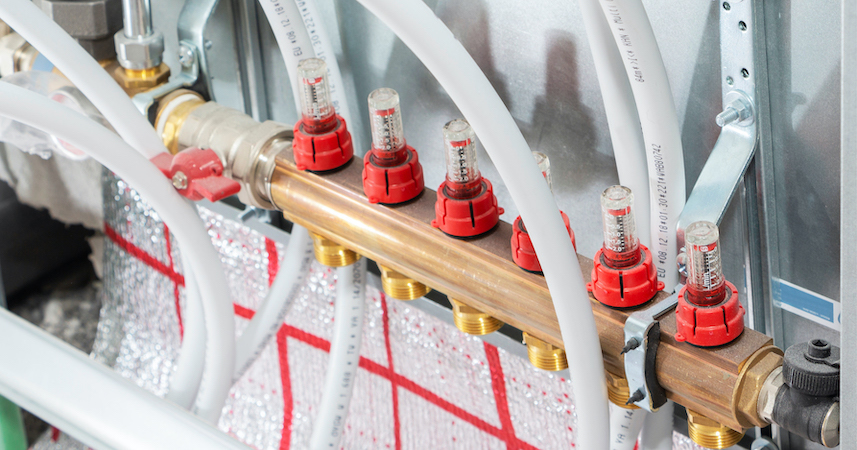What Is a Floor Heating Manifold?
A floor heating manifold is the central control system that manages the flow of water in underfloor heating systems. It distributes heated water from a heat source—usually a boiler, heat pump, or solar thermal system—through a network of pipes laid under the floor. The manifold regulates the flow of water to each loop of the underfloor heating pipes, ensuring an even distribution of heat across different zones in the building.
Without a floor heating manifold, it would be impossible to maintain proper control over an underfloor heating system. The manifold is responsible for regulating water temperature, flow rate, and pressure, allowing the system to deliver heat exactly where and when it is needed.
The Role of the In-Floor Heating Manifold
An in-floor heating manifold is simply a manifold specifically designed for use with underfloor heating systems. It performs the same functions as a general floor heating manifold, but it is optimized for distributing heat evenly across the entire surface of the floor. This ensures that the heat is spread consistently, without creating hot spots or leaving certain areas of the room cold.
Components of a Floor Heating Manifold
A typical floor heating manifold consists of several key components that work together to control the flow and temperature of water in the system:
1. Flow Meters
Flow meters are installed on the manifold to measure the flow of water into each loop of the system. They allow for precise control of water distribution, helping to ensure even heating throughout the space. If certain areas of the floor are cooler than others, adjustments can be made using the flow meters to increase or decrease the flow of water to that specific loop.
2. Temperature Gauges
Temperature gauges monitor the temperature of the water entering and leaving the manifold. This helps to ensure that the water circulating through the system is at the right temperature for efficient heating. Maintaining an optimal temperature is critical for both comfort and energy efficiency.
3. Balancing Valves
Balancing valves allow for the fine-tuning of water flow to different zones of the heating system. These valves help to maintain an even heat distribution across the entire floor, regardless of the size or shape of the room.
4. Actuators
Actuators are small devices that control the opening and closing of the manifold valves. They are typically connected to a thermostat, which signals the actuators to open or close the valves based on the temperature in each room. This allows for precise zone control, ensuring that different rooms can be heated to different temperatures as needed.
5. Mixing Valves
A mixing valve is used to regulate the temperature of the water entering the in-floor heating manifold. It mixes hot water from the heat source with cooler water from the return pipe to achieve the desired temperature. This is important because water that is too hot can damage the floor or make the room uncomfortably warm.
6. Isolation Valves
Isolation valves allow for sections of the manifold or the entire system to be shut off for maintenance or repair. These valves make it easy to work on the system without having to drain all the water from the pipes.
Why is the Floor Heating Manifold So Important?
The floor heating manifold is the brain of your underfloor heating system. It ensures that the right amount of heat is distributed to the right places at the right time. Without a properly functioning manifold, your heating system could become inefficient, leading to uneven heating, higher energy costs, and increased wear and tear on the system.
Key Functions of a Floor Heating Manifold:
- Regulates Water Flow: The manifold ensures that each loop in the underfloor heating system receives the correct amount of water flow, preventing areas from becoming too hot or too cold.
- Controls Temperature: By mixing hot water with cooler return water, the manifold ensures that the water circulating through the pipes is at the optimal temperature.
- Enables Zoning: A properly configured manifold allows for individual temperature control in different rooms or zones, increasing both comfort and energy efficiency.
- Reduces Energy Usage: By distributing heat evenly and efficiently, the manifold helps to minimize energy consumption, reducing heating costs.
- Improves System Longevity: Ensuring that water flows evenly and at the correct temperature helps to prevent damage to the system, prolonging its life.
Types of Floor Heating Manifolds
There are different types of floor heating manifolds, each with specific features designed to meet the needs of different heating systems.
1. Manual Manifolds
These manifolds are operated manually, with adjustments made using balancing valves and flow meters. While they are relatively simple and cost-effective, they do not offer the convenience or precision of more advanced options.
2. Automatic Manifolds
Automatic manifolds are equipped with actuators that respond to signals from thermostats, allowing for precise control of temperature and water flow. These systems are ideal for homes or buildings with multiple zones, as they allow for independent temperature control in each room.
3. Pre-Assembled Manifolds
Some floor heating manifolds come pre-assembled, with all components already installed and configured. These systems are quick and easy to install, making them a popular choice for both professionals and DIY enthusiasts.
4. Custom Manifolds
For more complex systems, custom manifolds can be designed to meet the specific needs of the installation. These systems are typically used in larger buildings or homes with unique layouts or heating requirements.
Choosing the Right Floor Heating Manifold
When choosing a floor heating manifold, there are several factors to consider to ensure you select the right one for your system.
1. Size of the System
The size of your underfloor heating system will determine the size and capacity of the manifold you need. Larger systems with multiple zones will require a more complex manifold with additional features such as actuators and mixing valves.
2. Number of Zones
If your home or building is divided into multiple heating zones, you’ll need a manifold that can support individual temperature control for each zone. Automatic manifolds with actuators and thermostats are ideal for this type of system.
3. Type of Heat Source
The type of heat source you are using—whether it’s a boiler, heat pump, or solar thermal system—will also affect your choice of manifold. Some manifolds are better suited for specific heat sources, so be sure to choose one that is compatible with your system.
4. Installation Location
The location where the manifold will be installed is another important consideration. Manifolds are usually installed in a dedicated cabinet or wall-mounted in a utility room, so you need to ensure that the manifold you choose fits the available space.
Installation of a Floor Heating Manifold
Installing a floor heating manifold is a critical step in setting up an underfloor heating system. It requires careful planning and precision to ensure that the system functions efficiently. Below are the basic steps involved in the installation of a floor heating manifold:
1. Choose the Installation Site
Select a location that is easily accessible for maintenance but out of the way of daily activities. The manifold should be installed in a utility room, hallway, or dedicated manifold cabinet.
2. Mount the Manifold
The manifold should be securely mounted on the wall or inside a cabinet. Ensure that the manifold is level and that there is enough space around it for easy access to the components.
3. Connect the Pipes
Each loop of the underfloor heating system will be connected to the manifold. The supply and return pipes from the heat source are also connected to the manifold. Make sure that all connections are secure and leak-proof.
4. Install Flow Meters and Valves
Once the pipes are connected, the flow meters, balancing valves, and other components can be installed. These components are crucial for controlling the flow and temperature of water in the system.
5. Test the System
After installation, the system should be thoroughly tested to ensure that there are no leaks and that the manifold is functioning correctly. This includes checking the flow meters, actuators, and temperature gauges.
Maintenance of a Floor Heating Manifold
To ensure that your floor heating manifold continues to operate efficiently, regular maintenance is essential. Here are some tips for maintaining your manifold:
1. Check for Leaks
Regularly inspect the manifold for any signs of leaks. Even a small leak can lead to a loss of efficiency and increased energy consumption.
2. Monitor Flow Rates
Ensure that the flow meters are set correctly and that water is flowing evenly through each loop of the system. If certain areas of the floor are not heating properly, adjustments may be necessary.
3. Clean the System
Over time, dirt and debris can accumulate in the system, reducing its efficiency. Periodically clean the manifold and the pipes to prevent blockages.
4. Inspect Valves and Actuators
Check the valves and actuators to ensure they are functioning properly. If any of these components are damaged or worn, they should be replaced immediately to maintain the system’s efficiency.
The Future of Floor Heating Manifolds
As technology continues to advance, we can expect to see further innovations in floor heating manifold. Smart thermostats, improved materials, and more efficient designs will help to make underfloor heating systems even more effective and energy-efficient in the future.
Conclusion
The floor heating manifold is an indispensable part of any underfloor heating system, ensuring that heat is distributed evenly and efficiently throughout a building. Whether you are a homeowner looking to install underfloor heating or a professional installer, understanding the role and function of the in-floor heating manifold is essential for creating a system that provides maximum comfort and efficiency.
With the right floor heating manifold, you can enjoy the many benefits of underfloor heating, including consistent warmth, energy savings, and improved comfort. By choosing the right manifold for your system, ensuring proper installation, and maintaining it regularly, you can create a heating system that will serve you well for years to come.

Jennifer David is the creative force behind CelebRiches, your go-to source for celebrity financial exploits. With an unwavering passion for the entertainment industry, she delivers in-depth insights into celebrities’ net worth, combining thorough research with a captivating narrative. Explore the stars’ fiscal journeys through Jennifer’s expert lens, where finance meets fame most engagingly.
